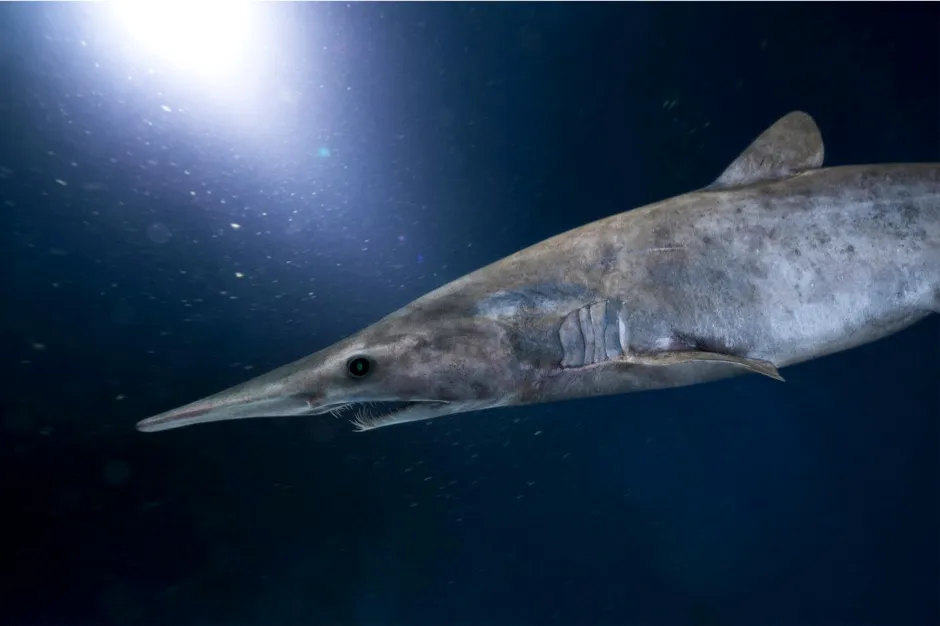Forget the great white shark from Jaws or the megalodon from The Meg: there’s a new superstar shark in town, and it’ll give you more nightmares than both of them combined. Meet the goblin shark.
Why is it called a goblin shark?
The secretive fish was first found off the eastern coast of Japan, where it was described in 1898. With its unusually long snout and fleshy skin tone, the shark was given the name tenguzame – a reference to a mythical Japanese monster with a long face, pink skin and demonic jaws, which led to the Western translation, ‘goblin shark’. The pink coloration is due to blood vessels shining through its translucent skin (see video, below).
Where does the goblin shark live?

The shark lives in the open ocean, at depths of 100 to 1,300 metres. It can be found in the Atlantic, Pacific and Indian Oceans, where it has a scattered, patchy distribution. It has been pulled up from the seas around Japan, New Zealand, France, Madeira, South Africa, Brazil and a number of other countries. There is some evidence that the goblin shark may occasionally move up into shallower waters, like many other deep-sea species.
How big are goblin sharks?
The goblin shark gives birth to live pups. When born, these are around 80 to 100cm in length. When mature, the males measure 260 to 380cm. Like most shark species, the females are larger, coming in at more than 420cm. Some whopping specimens of 620cm have also been discovered.
Read more:
What do goblin sharks eat?
With their small, slender teeth measuring less than 1cm across, goblin sharks probably chow down on small, soft-bodied fish and invertebrates.
In recent years, rare video footage has shown just how incredible those unusual jaws are. First, the goblin shark uses electroreceptors called ampullae of Lorenzini on its long nose to detect the electrical fields of its prey. Then, when prey is located, the goblin shark uses the natural buoyancy provided by its large, oil-rich liver to float silently towards its victim. When the unwary animal gets within range – SMASH! – a pair of extendable jaws filled with nail-like teeth lunge out from its face.
When the jaws are retracted, the goblin shark looks far less unusual, and more closely resembles other deep-sea shark species.
“When specimens of goblin sharks were first captured and recorded, their jaws were in the protruded position. Older textbooks illustrate the animals in this way,” says marine biologist Tom Hird. “In the past 10 years or so, scientists studying live specimens at depth using submersibles have helped us establish exactly how the jaw thrusts forward when the sharks feed.”
How many species of goblin sharks are there?
The goblin shark belongs to the family Mitsukurinidae, which contains one living species, the goblin shark. There are other extinct members of this family in the fossil record, which dates back some 125 million years. Previously, a number of specimens of goblin sharks were classified as different species, but this was due to preservation techniques fixing the jaws in different positions, leading to confusion.
Are goblin sharks endangered?
Goblin sharks certainly have an aura of mystery. They are not thought to be rare, yet so few animals have been found that it is hard to draw any conclusions about how abundant they are.
In every sense, the goblin shark is a creature ripe for Hollywood to exploit. Let’s just hope that it doesn’t follow in the path of many of its shark cousins and become exploited by fishing fleets, too.
About our expert, Tom Hird
Tom is a marine biologist and broadcaster. He is an ambassador for the Shark Trust, the Marine Conservation Society and the South African Shark Conservancy. He is the author of Blowfish's Oceanopedia: 291 Extraordinary Things You Didn't Know About The Sea (£10.99, Atlantic Books).
To submit your questions email us atquestions@sciencefocus.com(don’t forget to include your name and location)
